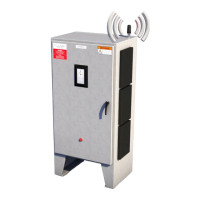19
Section 5: Genesis Controller Testing
and Start-Up
All heat trace circuits should be properly terminated
and megger tested prior to energizing the Genesis
Controller control panels. In addition, all pipes should
be insulated with weather barrier to achieve the
required temperatures to be maintained.
Troubleshooting Tips
When starting up a newly installed heat trace and
control system, it is common to encounter numerous
circuit alarms and possibly circuit “trip” events. Data
entry errors, unanticipated temperature conditions
and/or control band settings that are too narrow, and
other possible installation errors can be expected.
A table of Troubleshooting Tips is provided in
Appendix C to assist during start-up.
Section 6: Operation and Maintenance
of the Genesis Controller Control and
Monitoring System
6.1: Maintenance
Preventive maintenance consists of inspection,
testing, checking connections, and general
cleaning of equipment at scheduled intervals. The
maintenance recommendations that follow are
intended to support and in some cases “add to”
those procedures detailed in the facility’s Planned
Maintenance System (PMS). In case of conflicts,
contact the project engineer for resolution.
When carrying out the scheduled maintenance
program, the following safety precautions should
be observed. Safety Precautions the heat tracing
can be powered by the project specified nominal
voltages ranging from 100 to 600 Vac. It is important
that only authorized trained personnel conduct
these maintenance and service activities. Before
conducting any maintenance or service procedure,
exercise required lockout and tag out procedures
at the appropriate circuit breakers. Additionally, do
additional testing within the control panel to ensure
that the specific heat tracing and control circuit of
interest is fully de-energized and the equipment is
grounded. If it becomes necessary to service or test
this is typically +40 to 50°F (+5 to 10°C)). when the
ambient rises above this value, the heat trace will
turn off.
(This is a less energy efficient approach to heat
trace control, but is consistent with what is routinely
provided with ambient sensing mechanical
thermostats controlling a contactor between a
distribution panel’s main circuit breaker and the
branch breaker panel board.)
4.3: Control Method: On-Off with Soft Start
On-Off with soft start feature is restricted to us
with Solid State Relays. It utilizes “cycle omission”
techniques to ramp up to maximum allowable
heater power in a span of approximately 90 seconds.
This ramp-up feature is designed to specifically
address a) cold start power surges associated with
self-regulating and power limiting heaters, and b)
potential overshoot when utilizing high wattage
heaters in low heat loss applications.
This control method is only used with the zero
crossing solid state current switching relay
configurations as these control modes pulse power
very rapidly during start-up, power clamping, and/or
when employing a full proportional control algorithm.
If “on/off with soft start” is selected with any Power
Clamp percentage other than 100% the circuit will
operate as follows:
Below the Low Temperature alarm (LTA) setpoint, the
heater will be “full on” 100% of the time.
When the temperature reaches/exceeds the LTA, the
soft start feature will energize the heater “full on” for
the Power Clamp (time) percentage selected (n% of 1
second) and over 90 seconds will ramp up to “full on”
for 100% of the time.
Regardless of what Power Clamp (time) percentage is
selected, it will take a maximum of 90 seconds for the
heater to be “full on” for 100% of the time.
The heater will be turned off once the Maximum
Temperature (Maintain Temperature plus Control
Ambient “On-O” Control when ambient temperature
falls below desired Maintain Temperature
Band, or MT+CB) is reached, even if that temperature
is reached in less than 90 seconds.
Once the heater is at MT+CB (Maximum
Temperature), it will continue to cycle based on
the soft start settings. In other words, once MT+CB
is reached the heater is de-energized until the
temperature drops to the Maintain Temperature (MT),
then the heater will be energized “full on” starting at
the selected Power Clamp (time) percentage (n%) and
will go through the 90 second ramp up to “full on” for
100% of the time, or until the MT+CB is again reached.

